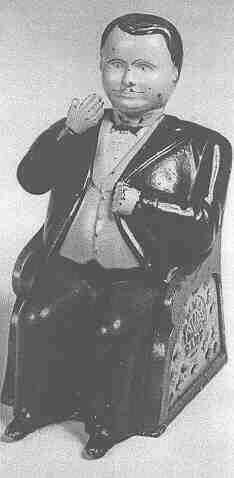Tammany Bank
by F.H. Griffith - HOBBIES Magazine - April, 1983
 Probably the most popular mechanical bank of all times is our choice as No. 300
in the numerical classification. This is the Tammany Bank with its extra fine action of
pocketing the coin and nodding the head in thanks.
Probably the most popular mechanical bank of all times is our choice as No. 300
in the numerical classification. This is the Tammany Bank with its extra fine action of
pocketing the coin and nodding the head in thanks.
A considerable amount of intrigue surrounding the bank has to do with its being an effigy or representation of the infamous Boss Tweed of Tammany fame. Well, if this be the case, the figure has no resemblance to Boss Tweed whatsoever. It is rather doubtful that either Hall or Frisbie had Tweed himself in mind when the bank was originally designed. It was, in fact, at one time simply called Little Fat Man Bank.
In later productions of the bank, after an initial run for a period of time with no name, the name Tammany was added to the pattern and subsequent banks over a period of many years bore this name.
The first to patent the bank was John Hall of Watertown, Massachusetts. This patent was issued December 23, 1873. The drawings accompanying this patent are rather weird looking, however, the basic principle of the operation is accurately defined.
On June 8, 1875, the bank was again patented, but this time by Russel Frisbie of Cromwell, Connecticut. While the patent drawings in this patent look more like the actual bank itself, the operation was different in that the right foot was pressed to activate the right arm.
Remember John Hall was more or less obsessed with the idea of the weight of a coin working any bank, or in certain cases activating the mechanism as, for example, his Horse Race Bank. In any case, the Tammany Bank as manufactured was based on his patent and it operated by the weight of the coin. Also, Hall’s original patent date of 1873 is inscribed on the back top edge of the chair.
This all follows through with very important bearing on the fact that on October 9, 1877, a patent was re-issued to John Hall covering the same bank with the diagrams more in line with the way the bank really looks. This patent has a bank. In the patent Hall refers to the bank as "My invention relates to a toy money box which I term ‘The Tammany Bank’ and consists of a figure of a man." So much for that and the name.
One more fact in the background of this interesting bank. Each of Hall’s patents, 1873 and 1877, show the right arm triggered by a wire lever. This is not the case in production — he stayed right with his weight of the coin thing only.
This bank shown is in fine pristine condition, all original with a few slight paint chips. Colors are as follows: The chair is tan with a mottled orange-brown outlining. The figure wears a black jacket, yellow vest, white shirt, blue bow-tie, brown trousers, and black shoes. His face and hands are flesh color. His hair, moustache, and features of his face are all black.
To operate, a coin is placed in his right hand which lowers (from the weight of the coin) to his left hand where it drops into the provided slot pocket. In so doing the head nods forward, caused again by the weight of the coin.
A top mechanical bank, albeit it is one of the most common. It was a popular well liked bank in its time and this has carried right through to its becoming a very desirable collector’s item. Manufacturer — J. & E. Stevens Co., Cromwell, Connecticut.
